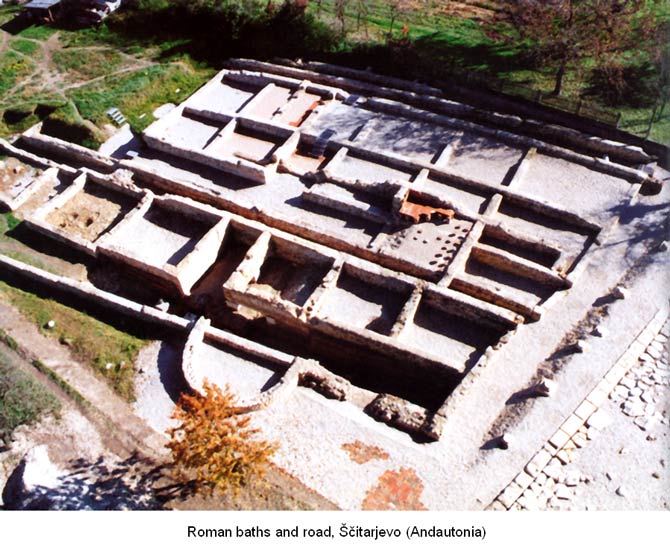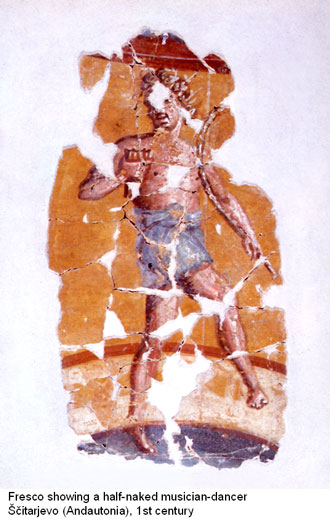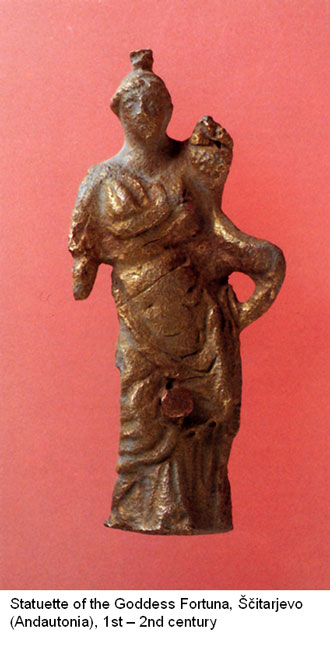Zagreb before Zagreb
Organisers: Zagreb City Museum, Archaeological Museum Zagreb, Brdovec Museum, Prigorje Museum, Turopolje Museum, Croatian Natural History Museum
Exhibition design: Željko Kovačić

Until recently Zagreb's archaeological heritage was almost unknown both in Croatia and abroad. The archaeological material left by the march of history in the wider area of the present city was known only to a few individuals, experts in the field, and to those who were curious enough to search for information with perseverance and ingenuity. In spite of this, and of undeserved media obstruction, earlier archaeologists opened the door to the past of the greater Zagreb region and to life in it, which is many thousands of years old. Their research came out over the years in various publications, monographs, scholarly and professional articles, exhibition catalogues etc. Today it forms the basis for a clearer reading of the oldest history of the city, a history that we are now able to piece together from scattered fragments of a confused mosaic, and thus to present a harmonious composition that owes a lot to the fundamental research of our predecessors.
In recent years archaeological research in the Zagreb region has been especially intense, and yielded increasingly rich and important results. Many people will be surprised by the outstanding archaeological heritage, presented for the first time in the form of a representative exhibition mounted to mark a specific occasion. Direct contact with actual sights and relics is more convincing than even the best publications, which can only give readers an inkling of the quality and number of archaeological remains discovered in the Zagreb area. Important archaeological research is still under way and recent discoveries suggest the presence of many more unsuspected and interesting finds. Surprises may still be in store for us in Zagreb's many sites. 1994 was the jubilee year of the city and its bishopric, and this seemed an appropriate context for an exhibition presenting the material remains of life in the Zagreb region up to 1094, the year when the bishopric was founded. The idea to mount this exhibition on the 900th anniversary of the bishopric and the first mention of Zagreb in written documents is several years old, and work on it began in 1990. New and sometimes completely unexpected discoveries supplemented the original plan of the exhibition, and its final form is different and certainly richer and more meaningful than had originally been conceived by its authors. Circumstances surrounding the development of plans for the exhibition also changed, and there were necessary changes in the institutions that realized the project. Besides the Zagreb Archaeological Museum, which was one of the initiators of the project and its main proponent throughout, the Museum of Prigorje, Sesvete and the Museum of Turopolje, Velika Gorica actively participated in the work for its whole duration, and the Samobor and Brdovec Museum was later replaced by the Zagreb City Museum. The participation of the Zagreb City Museum in the project, and the decision to mount the exhibition in its new and adapted exhibition premises, was primarily motivated by the desire to present not only movable material, but also the newest finds that were discovered in the museum's very grounds, and if possible the multistrata Gradec locality itself in situ, or at least part of it (including the remains of a prehistoric hill fort settlement – residential structures, fortifications, fireplaces, a kiln and furnace etc. – from the Late Bronze Age, i.e. from the period of the urn-field culture, and finds from tbe Early and Late Stone Age, also much later medieval finds, especially very interesting remains of wooden fortification architecture important for the history of architecture of medieval Gradec and Zagreb). Although these hopes of the organizers could not be fully realized, we feel sure that the atmosphere of that unique archaeological locality will nevertheless enhance the experience of visitors to the exhibition.
It took many years to get this project ready, and it was intended as one of a group of diverse events to mark a specific occasion. We must mention here some of the accompanying activities planned for the period up to the opening of the exhibition, which were of great interest to the public. The most important was the inauguration of an archaeological park in Ščitarjevo, Roman Andautonia, the first classical locality in the Zagreb region to be presented to the public. The city baths, a paved street and the remains of a porch are a rare example of a well-researched, conserved and restored classical architectural complex in north Croatia and are thus especially interesting. The initiators of this exhibition have also encouraged the marking of sites where important archaeological remains were found. This has been systematically carried out during recent years, although under partly changed circumstances.

Now after the most recent archaeological excavations and new research in the whole Zagreb area during the last few years, it seems necessary to redefine the concept of Zagreb as a historic, i.e. medieval city.
 Zagreb is a “historic city” and much of its identity has emerged from its rich historical, especially medieval heritage. However, the city also has another, less visible face, that is becoming increasingly readable and forceful every day. Today we can talk about a kind of Zagreb acropolis (“high upper city”), a prehistoric settlement in the very town nucleus. This important discovery illuminates the past life of the area from another angle. Zagreb is thus a “prehistoric city”, too. Numerous monuments and localities from the Roman age have also been found in the city area. They best show the continuity and density of human settlement in the region in that period, although there is no confirmation of the existence of any urban community as a predecessor of later medieval Zagreb. In spite of indisputable urban discontinuity, because there was no urban community in what is today the city nucleus during the several centuries of Roman rule, there is no doubt that the proximity of Roman Andautonia, an urban centre located on the site of today's picturesque village of Ščitarjevo near the Sava, influenced the life and customs of people who inhabited the hamlets and rural dwellings scattered throughout today's city. Thus Zagreb was not skirted by the Roman spirit, and some forms of Roman civilization that came to expression in the urbanized environment of the nearby Roman city, also affected the rural tissue of what is today the city nucleus. All this changes the previous conception of Zagreb and it is not unreasonable to conclude that its archaeological heritage brings the Croatian capital culturally very close to the most important European, especially Central-European, cities. The newest Late-Roman finds in Kuzelin in the Sesvete area, and the early-medieval, Early-Croatian finds recently made in Stenjevec, which are earlier, concurrent or slightly later than the foundation of Zagreb Bishopric, show both the continuity of settlement in the wider Zagreb region, and a cultural level we can really be proud of. What is more, finds from Veternica Cave near Zagreb, over 50 thousand years old, move human habitation in the region even further back, making Zagreb one of the few major cities that measure their past in tens of thousands of years.
Zagreb is a “historic city” and much of its identity has emerged from its rich historical, especially medieval heritage. However, the city also has another, less visible face, that is becoming increasingly readable and forceful every day. Today we can talk about a kind of Zagreb acropolis (“high upper city”), a prehistoric settlement in the very town nucleus. This important discovery illuminates the past life of the area from another angle. Zagreb is thus a “prehistoric city”, too. Numerous monuments and localities from the Roman age have also been found in the city area. They best show the continuity and density of human settlement in the region in that period, although there is no confirmation of the existence of any urban community as a predecessor of later medieval Zagreb. In spite of indisputable urban discontinuity, because there was no urban community in what is today the city nucleus during the several centuries of Roman rule, there is no doubt that the proximity of Roman Andautonia, an urban centre located on the site of today's picturesque village of Ščitarjevo near the Sava, influenced the life and customs of people who inhabited the hamlets and rural dwellings scattered throughout today's city. Thus Zagreb was not skirted by the Roman spirit, and some forms of Roman civilization that came to expression in the urbanized environment of the nearby Roman city, also affected the rural tissue of what is today the city nucleus. All this changes the previous conception of Zagreb and it is not unreasonable to conclude that its archaeological heritage brings the Croatian capital culturally very close to the most important European, especially Central-European, cities. The newest Late-Roman finds in Kuzelin in the Sesvete area, and the early-medieval, Early-Croatian finds recently made in Stenjevec, which are earlier, concurrent or slightly later than the foundation of Zagreb Bishopric, show both the continuity of settlement in the wider Zagreb region, and a cultural level we can really be proud of. What is more, finds from Veternica Cave near Zagreb, over 50 thousand years old, move human habitation in the region even further back, making Zagreb one of the few major cities that measure their past in tens of thousands of years.
Chronologically laid out by the architect Željko Kovačić, the exhibits are arranged in several groups. The Odyssey through past times begins with Palaeolithic (Early Stone Age) finds, various objects in stone and bone from 50 thousand to 100 thousand years old. Then follows Neolithic (Late Stone Age, 6th and 5th millennium B.C.) and Eneolithic (Copper Age, 4th and 3rd millennium B.C.) material, assembled from various Zagreb localities: Jarun, Staro Čiče and Kuzelin, Dubranec etc. Different phases of the Bronze Age (2200 – 750/700 B.C.) are represented by finds (ceramics, gold jewelry, bronze swords) from hoards and necropolises in Moravče-Draščica, Vrapče, Horvati, Dežman passage, Medvedgrad etc. There are relatively few finds from the Early Iron Age (750 – 400 B.C.), including those found in Gradec only a storey or so below the place where they are now exhibited. The same is true of finds from the Late Iron Age (300 B.C. – A.D. 50), which came from the same locality and from Kuzelin, Jarun etc. The hall with classical (Roman) exhibits (1st – 4th c.) is dominated in number and variety, and also in quality, by finds from Ščitarjevo, Roman Andautonia (stone sacrificials and honorary inscriptions, manycoloured figurative frescoes, remains of luxurious marble tiles, numerous ceramic objects, glass dishes, pharmaceutical equipment, jewelry, metal objects for everyday use, small bronze sculptures, gold, silver and bronze coins etc.).
 The exhibits also include fine monuments recently discovered and restored for the needs of this exhibition, for example frescoes that are a unique find in this region, and also a small bronze statuette of Fortuna, goddess of fortune and prosperity, found in the year of Zagreb's great jubilees. We would like to recognize the destiny of the city this unusual exhibition is dedicated to in that figurine, symbol of plenty. The finds from Andautonia are joined by others (stelae, ceramics, coins etc.) discovered in various localities throughout Zagreb, either by chance or during protective excavations (Stenjevec, corner of Savska Street and Vukovar Avenue, intersection of Vukovar and Držić Avenues, Petrinjska Street, Ribnjak, Odra, Donji Čehi etc.). The exhibition ends with the Late-Roman period and the Early Middle Ages (400 – 1094). Various finds from the fortified settlement Kuzelin, Donja Glavnica and Moravče (metal and clay dishes, tools, weapons etc.) are outstanding Late-Roman material. Especially interesting is the well-known bronze lamp in the form of a lamb (Agnus Dei) with an embossed Christogram on its head, found on Mirogoj Road in Zagreb, one of the most beautiful Early-Christian monuments from the wider Zagreb region. The exhibition ends with finds from a horseman's grave in Kruge, warrior's equipment from the grave under Susedgrad, the wellknown finds from Kaptol (earrings), and the espe cially important finds from Stenjevec, both the oldest ones from the seventh century and those that were discovered during recent research (silver jewelry, mostly temple accessories) that belong partly to the time of Early-Croatian rulers.
The exhibits also include fine monuments recently discovered and restored for the needs of this exhibition, for example frescoes that are a unique find in this region, and also a small bronze statuette of Fortuna, goddess of fortune and prosperity, found in the year of Zagreb's great jubilees. We would like to recognize the destiny of the city this unusual exhibition is dedicated to in that figurine, symbol of plenty. The finds from Andautonia are joined by others (stelae, ceramics, coins etc.) discovered in various localities throughout Zagreb, either by chance or during protective excavations (Stenjevec, corner of Savska Street and Vukovar Avenue, intersection of Vukovar and Držić Avenues, Petrinjska Street, Ribnjak, Odra, Donji Čehi etc.). The exhibition ends with the Late-Roman period and the Early Middle Ages (400 – 1094). Various finds from the fortified settlement Kuzelin, Donja Glavnica and Moravče (metal and clay dishes, tools, weapons etc.) are outstanding Late-Roman material. Especially interesting is the well-known bronze lamp in the form of a lamb (Agnus Dei) with an embossed Christogram on its head, found on Mirogoj Road in Zagreb, one of the most beautiful Early-Christian monuments from the wider Zagreb region. The exhibition ends with finds from a horseman's grave in Kruge, warrior's equipment from the grave under Susedgrad, the wellknown finds from Kaptol (earrings), and the espe cially important finds from Stenjevec, both the oldest ones from the seventh century and those that were discovered during recent research (silver jewelry, mostly temple accessories) that belong partly to the time of Early-Croatian rulers.
All the major events during recent archaeological excavations and the protection and presentation of archaeological localities and monuments, various exhibition projects, marking the sites of important archaeological finds and localities in the Zagreb region were, to a greater or lesser degree, was part of the great city jubilee celebrations. The crown of all these ventures is this exhibition, prepared with a twofold purpose. First, to turn public attention to little-known stages in the life of this region, to the periods that preceded the important events of the end of the eleventh century. Second, emerging from the first, to show, as we have always desired, the richness of the archaeological heritage – si parva licet componere magnis – that places Zagreb among cities that enjoyed Fortuna's favour during long centuries and millennia.
The help and cooperation of many institutions and individuals was necessary to realize these projects, and especially this exhibition. This especially refers to the authors of the exhibition and its layout, the writers of texts in this catalogue, all who contributed material, institutions and individuals who gave financial and other support in the realization of the project, restorers, photographers and many others whose are mentioned in other places in this catalogue. We are also grateful to those whose names are not on this list, but who contributed to what we have tried to achieve. All this has resulted from a lot of work, and rather less from luck. Nevertheless, Fortuna in omni re dominatur! In these times we really need good fortune, perhaps more than ever in the past.
Ante Rendić-Miočević
Pictures from the exhibition


.jpg) Exhibition catalogue
Exhibition catalogue
Rendić-Miočević, Ante; Želimir Škoberne; Jakov Radovčić; Ivan Cvitković; Dubravka Balen-Letunić; Zoran Gregl; Zdenka Dukat; Dorica Nemeth-Ehrlich; Pavo Vojvoda; Vladimir Sokol. Zagreb before Zagreb : The archaeological heritage of Zagreb from prehistory to the foundation of the Bishopric in 1094.
Zagreb : Archaeological Museum Zagreb ; Zagreb City Museum ; Sesvete : Prigorje Museum ; Velika Gorica : Turopolje Museum, 1994

